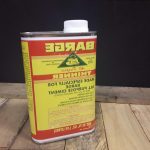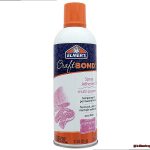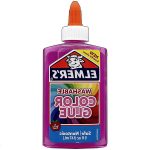Hey there, fellow crafters and DIY enthusiasts. Welcome to our blog, where we get down and dirty with all things adhesive-related. Today, we’re tackling a burning question that’s been on everyone’s minds: is B-7000 as good as E6000?
Now, both B-7000 and E6000 are big players in the adhesive game, each with their own special qualities and quirks. In this post, we’re going to dig deep into the nitty-gritty details of these two adhesives. We’ll be exploring what sets them apart, what they bring to the table, and how they can level up your crafting projects.
Let’s face it – choosing the right adhesive can make or break your masterpiece. Whether you’re a seasoned DIY pro or just starting out on your creative journey, it’s crucial to know which glue will stick (pun intended) by your side through thick and thin.
So buckle up, folks. Get ready for an epic showdown between B-7000 and E6000 as we uncover their secrets and spill the glue… I mean tea… on which one reigns supreme in the world of adhesives. Let’s get sticky.
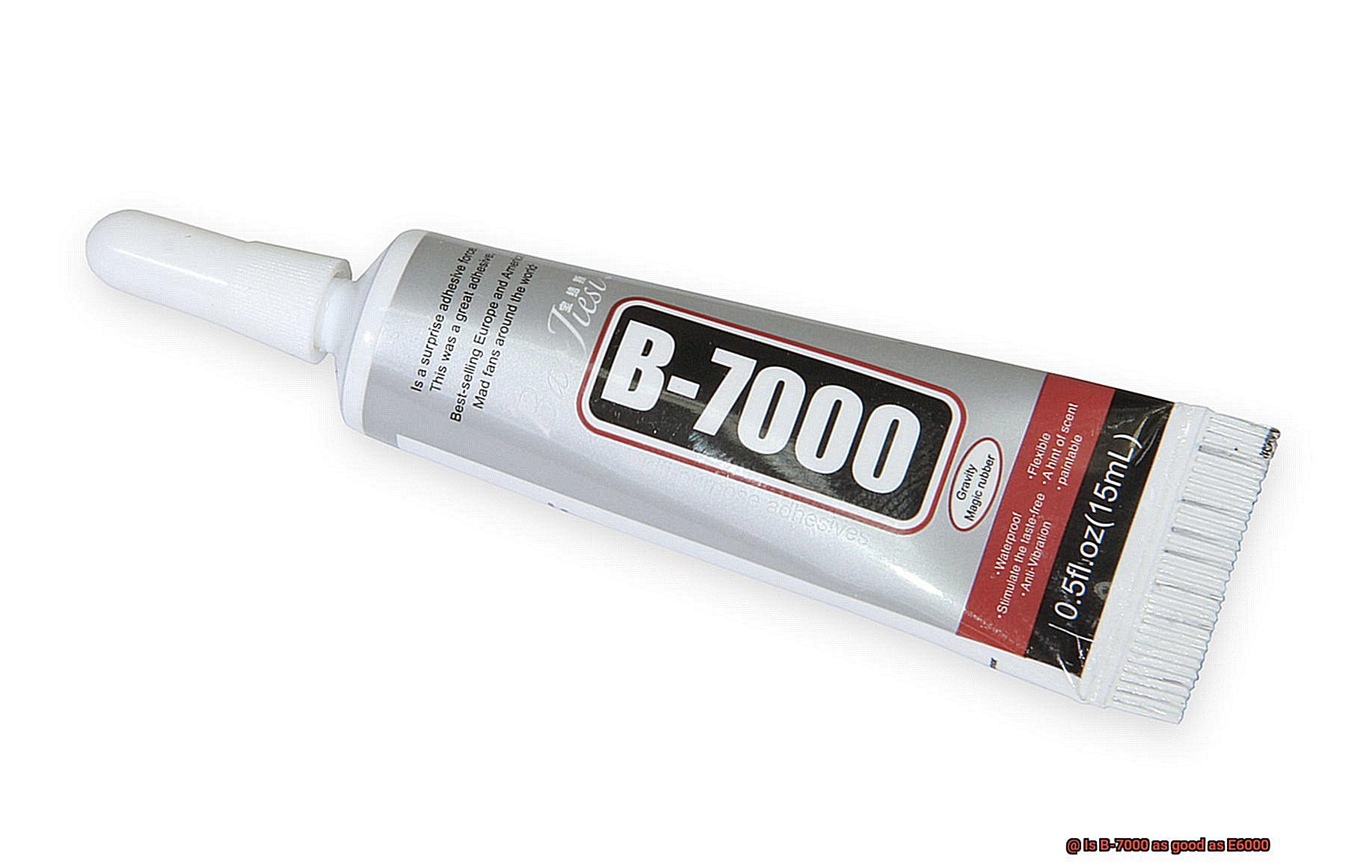
Overview of B-7000 and E6000
Contents
When it comes to choosing the perfect adhesive for your crafting, DIY, or repair projects, B-7000 and E6000 are two names that frequently come up. These versatile glues offer exceptional bonding capabilities and are highly regarded by professionals and enthusiasts alike. In this comprehensive overview, we will delve into the similarities and differences between B-7000 and E6000, empowering you to make an informed decision for your next project.
Similarities:
- Versatility: B-7000 and E6000 can bond an extensive range of materials including glass, metal, plastic, fabric, wood, and ceramics. This versatility makes them suitable for a wide variety of applications.
- Clear and Flexible Bonds: Both adhesives dry to a crystal-clear finish and provide flexibility once cured. This allows for movement without compromising the bond, making them ideal for projects that require some flexibility.
- Resistance to Water: Both glues possess excellent resistance to water, making them suitable for outdoor projects or items that may be exposed to moisture.
Differences:
- Odor: B-7000 has a relatively mild odor compared to the potent smell of E6000. If you are sensitive to strong odors or working in enclosed spaces, this could be a crucial factor to consider.
- Drying Time: B-7000 generally dries faster than E6000, which may take longer to cure completely. If your project necessitates quick bonding and immediate use, B-7000 may be the superior choice.
- Flexibility vs. Strength: B-7000 is renowned for its exceptional strength and ability to withstand vibrations and shocks, rendering it ideal for heavy-duty applications. On the other hand, while E6000 also provides a robust bond, it is more rigid in nature. Consider the level of durability required for your project when choosing between the two.
- Pricing: B-7000 tends to be more economical than E6000, making it a cost-effective option for budget-conscious crafters and DIYers.
Drying Time Difference
We are here to delve into the fascinating world of drying time difference between two renowned adhesive glues: B-7000 and E6000.
Let’s commence with the lightning-fast B-7000. This adhesive is celebrated for its relatively rapid drying time, requiring a mere 5 to 10 minutes to dry and become tack-free. In the blink of an eye, you can resume your project. B-7000 employs a solvent-based formula, enabling swift evaporation and an accelerated drying process. With this glue, you can achieve an instantaneous bond or expedite your project’s completion.
Now, let us venture into the realm of E6000. Brace yourself, for this glue necessitates a longer drying period, spanning from 24 to 72 hours to fully cure and become tack-free. But fret not; this protracted duration does not imply inferiority in any way. E6000 is a viscous rubber cement that requires air drying and a meticulous curing process. However, once it reaches full maturity, it bestows upon you an unyielding and resilient bond capable of withstanding even the most formidable challenges.
So, how do you determine which glue to wield? Well, it hinges on your precise project requirements. If you crave a swift bond and are content with compromising some strength, B-7000 is your ticket to success. Conversely, if you demand unparalleled strength, durability, and flexibility, E6000 is your faithful companion.
Flexibility Difference
In the captivating world of adhesive glues, two popular contenders, B-7000 and E6000, vie for the crown with their unique qualities. Today, we unravel the mystery surrounding their flexibility difference. Prepare to be immersed in the realm of glue enthusiasts and crafty individuals as we delve into this fascinating topic.
When it comes to flexibility, B-7000 reigns supreme. This adhesive glue boasts exceptional flexibility, allowing it to bond various materials without succumbing to cracks or breaks under stress. Picture this: you’re attaching dazzling gems or rhinestones to delicate fabric or supple leather, and you need a glue that can withstand movement and flexibility. B-7000 is your go-to choice, ensuring that your precious creations remain intact even when subjected to bending or stretching.
However, don’t dismiss E6000 just yet. While it may not possess the same level of flexibility as B-7000, it still offers a reliable and robust bond. It’s important to note that E6000 may be more prone to cracking or breaking when faced with significant stress or movement. So, if your project doesn’t require as much flexibility, E6000 can still provide a sturdy hold.
Before making a decision, consider the specific needs of your project. Are you seeking maximum flexibility? If so, B-7000 emerges victorious. However, if your project demands exceptional strength and durability while sacrificing some flexibility, then E6000 faithfully accompanies you on your creative journey.
Remember, both glues possess unique properties beyond flexibility. Factors such as drying time, odor, and resistance to environmental conditions should also be taken into account. Conducting a small test on a sample before committing to one glue over the other can save you from unexpected surprises.
Water Resistance
From sealing plumbing fixtures to bonding materials for underwater use, we’ve got you covered.
B-7000: The Flexible Champion:
In the realm of flexibility, B-7000 reigns supreme. This glue possesses exceptional qualities that allow it to bond various materials without succumbing to cracks or breaks under stress. Imagine attaching dazzling gems or rhinestones to delicate fabric or supple leather – B-7000 is your go-to choice. With its flexibility, it ensures that your precious creations remain intact even when subjected to bending or stretching.
E6000: The Water Resistance Expert:
While B-7000 excels in flexibility, E6000 takes center stage in terms of water resistance. This glue is specifically designed to provide a waterproof bond, making it an ideal choice for projects exposed to moisture or submerged in water. Are you repairing outdoor gear like tents or boots? Look no further than E6000. It can even bond materials for underwater use. Its remarkable water resistance sets it apart from other glues in its class.
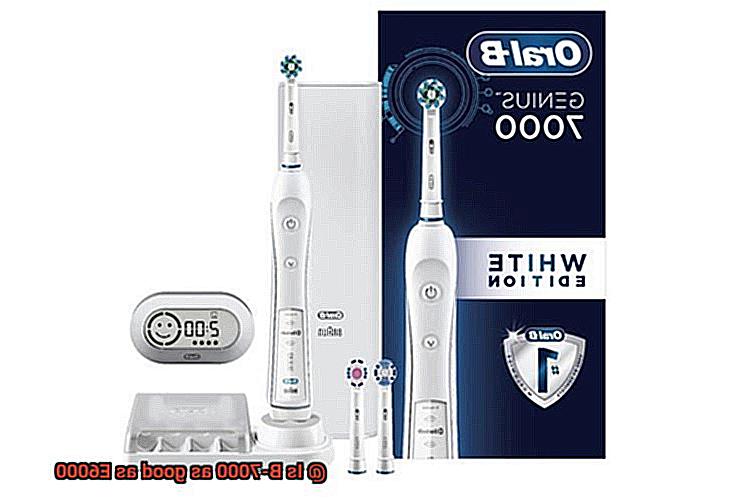
Choosing the Right Glue:
When it comes to water-resistant projects, it’s crucial to consider specific requirements and the level of water exposure they’ll encounter. If your project demands a strong and reliable bond in wet conditions, E6000 is the recommended choice. Its superior water resistance ensures durability even in the face of moisture or submersion. However, if flexibility is paramount and water exposure is minimal, B-7000 will be your trusted companion. Both glues possess unique properties beyond water resistance, such as drying time, odor, and resistance to environmental conditions. Consider these factors before making your decision.
Odor Comparison
Glue, while not the most thrilling topic, holds a world of intriguing scents within its sticky confines. In this exploration, we delve into the odorous realms of B-7000 and E6000 adhesives, comparing their distinct aromas.
Let’s begin with B-7000, renowned for its chemical-like scent. Users have likened it to the pungency of rubber cement or the wafting fumes of nail polish remover. A rather unappealing olfactory experience, especially in tight spaces or for those with sensitive noses. Even after drying, the lingering smell can prove bothersome to some.
Now, let’s shift our attention to E6000, boasting its own unique fragrance reminiscent of a blend between gasoline and nail polish remover. Perhaps not the most delightful aroma, but we are discussing glue after all. Similar to B-7000, this adhesive’s odor can persist long after it has cured.
It is worth noting that the strength of these odors varies from person to person and batch to batch. What one finds tolerable, another might find overwhelming. To combat the impact of these scents, it is advisable to work in well-ventilated areas or even outdoors if feasible. Donning a mask or utilizing a fan to circulate air can also aid in minimizing exposure.
When choosing between B-7000 and E6000, remember that odor is just one factor to consider. Both adhesives possess their own unique strengths and weaknesses regarding adhesive potency, flexibility, drying time, and compatibility with different materials. Therefore, it is prudent to weigh all these facets before making an informed decision.
Price Difference
While both these adhesives offer impressive bonding capabilities, one factor that often comes into play is the price difference between the two. In this article, we will explore the concept of price difference in relation to B-7000 and E6000 adhesives, shedding light on how it should be considered when selecting the perfect glue for your project.

Affordability – B-7000:
B-7000 adhesive holds a distinct advantage in terms of affordability. Generally priced lower than E6000, it becomes a budget-friendly option for crafters seeking reliable bonding without breaking the bank. Whether you’re working on jewelry making, fabric projects, or small DIY repairs, B-7000 delivers exceptional value for money.
Factors to Consider:
While price is an important consideration, it should not be the sole determining factor when choosing an adhesive. Several other aspects must be evaluated to ensure the adhesive is well-suited for your project:
- Application: Consider the specific application requirements of your project. B-7000 excels at bonding lightweight materials such as fabric, plastic, and leather. However, if your project involves heavy-duty bonding or challenging surfaces like metal or glass, E6000 may prove to be a better choice.
- Drying Time: Different adhesives have varying drying times. B-7000 typically dries faster than E6000, making it suitable for projects that require quicker turnaround times. If time is of the essence, this aspect becomes crucial in your decision-making process.
- Bonding Strength: E6000 is renowned for its exceptional bonding strength across various materials. If your project demands a strong and durable bond, investing in E6000 can be advantageous in the long run. While B-7000 offers reliable bonding, E6000 takes it up a notch for more demanding projects.
Making an Informed Decision:
To make the best choice between B-7000 and E6000, it is crucial to consider the complexity and durability required for your project. If you’re engaged in simple crafts or temporary fixes, B-7000’s affordability may be the ideal option for you. On the other hand, if you need a robust and versatile adhesive for more complex projects or permanent repairs, investing in E6000 is worth the extra cost.
Project Dependence
Project dependence is a crucial factor to consider when comparing adhesives like B-7000 and E6000. It refers to how well a glue performs in different applications and projects, taking into account the specific requirements, materials, and environmental conditions. Both B-7000 and E6000 are multipurpose adhesives commonly used in various craft and DIY projects, but their effectiveness can vary depending on the project at hand.
Let’s start with B-7000, the flexible friend you’ve always wanted. This adhesive is known for its versatility, bonding a wide range of materials such as fabric, leather, plastic, metal, and glass. It’s perfect for projects that require a strong bond that can withstand movement or flexing. Imagine attaching a fabric patch to a leather jacket – B-7000 will keep it secure even when you’re on the move.
Now, let’s switch gears to E6000, the Hulk of glues – strong and durable. It excels at bonding heavy-duty materials like wood, metal, ceramics, and stone. If you’re constructing furniture or repairing ceramic pottery, E6000 is your go-to adhesive with its exceptional strength and long-lasting properties.
However, it’s important to note that both adhesives have limitations. B-7000 may not hold up well in extreme temperatures or areas exposed to water or moisture. On the other hand, E6000 may not be suitable for projects that require flexibility or stretching.
To determine which adhesive is right for your project, consider the specific requirements of your application. What materials are you working with? Will there be any movement or flexing involved? And what are the environmental conditions that the adhesive will be exposed to?
To make an informed decision, conduct small-scale tests before diving into a full-scale project. This way, you can ensure compatibility and effectiveness.
Manufacturer Instructions
Today, we’re diving into the world of B-7000 and E6000 adhesives – powerful glues that can make your projects stick like magic. But here’s the catch – to unleash their full potential, you need to master the art of following manufacturer instructions. Let’s explore why this is so crucial.
Mastering Application Techniques:
The manufacturer instructions are like a secret recipe for adhesive success. They provide step-by-step guidance on how to apply B-7000 and E6000 correctly. Whether it’s brushing, squeezing, or dabbing onto the surface, these instructions are your roadmap to optimal coverage and bonding strength.
Patience is a Virtue: Curing Time Matters.
Ever rushed a project only to find your adhesive hasn’t fully cured? It’s frustrating, right? Well, fear not. The manufacturer instructions offer vital insights into how long it takes for B-7000 and E6000 to reach their maximum strength. By allowing sufficient curing time, you’ll achieve bonds that can withstand the test of time.
Finding Perfect Partners: Recommended Surfaces
Not all surfaces are equal when it comes to adhesion. The manufacturer instructions highlight which materials work best with B-7000 and E6000 adhesives. Say goodbye to weak bonds or damaging your project by double-checking these recommended surfaces before gluing fabric to leather or metal to plastic.
Safety First: Handle with Care
Adhesive products can contain chemicals that may be harmful if mishandled. That’s why the manufacturer instructions include safety precautions and handling guidelines. Following these instructions ensures your well-being and minimizes any risks associated with using B-7000 and E6000 adhesives.
Strive for Excellence: Optimal Performance
Adhesive success is all about optimal performance. Deviating from the manufacturer instructions can compromise bond strength and longevity. Stick to the provided guidelines, and you’ll achieve the best results with B-7000 and E6000 adhesives, making your projects sturdy and reliable.
iYZr5wuI6sQ” >
Conclusion
In conclusion, both B-7000 and E6000 are exceptional adhesives, each with its own unique qualities. They offer versatility, creating bonds that are both clear and flexible while also being resistant to water. If you’re in a hurry, B-7000 is your best bet as it dries faster. However, if you’re willing to wait a bit longer for a stronger hold, E6000 is the way to go.
When it comes to flexibility, B-7000 takes the crown. It can withstand movement and stretching without losing its grip. On the other hand, E6000 provides a reliable and sturdy hold that won’t let you down.
If water resistance is a priority for your project, then E6000 is the adhesive of choice. It can handle moisture and even submersion in water without compromising its bond. However, if your project doesn’t involve much exposure to water and flexibility is key, then B-7000 will be your trusted companion.
Both adhesives have distinct smells that may linger even after curing. To avoid any discomfort or irritation, make sure to work in well-ventilated areas or take your projects outdoors when using these glues.
In terms of price, B-7000 tends to be more affordable than E6000. This makes it a great option for crafters and DIY enthusiasts who want quality without breaking the bank.
Ultimately, the choice between B-7000 and E6000 depends on your specific project requirements. Take into account factors such as drying time, flexibility needs, water resistance, odor tolerance, and budget constraints when making your decision. Conducting small-scale tests before committing to one glue over the other can help ensure compatibility and effectiveness for your project.



